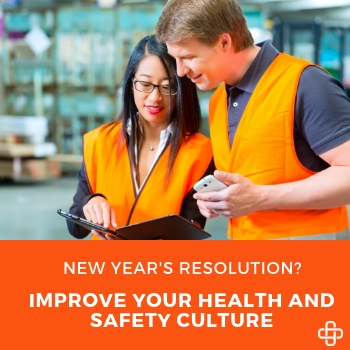Is an Injury or Illness Actually Work Related?
 While December is typically a time to reflect back on accomplishments, it also presents an opportunity to assess your health and safety culture.
While December is typically a time to reflect back on accomplishments, it also presents an opportunity to assess your health and safety culture.
But how? We’ll show you in just a few simple steps!
Safety Culture Improvement Tips
Do any of the following statements describe your organization? If not, this is the perfect time to get your work environment primed and ready for a safe new year!
- There’s visible evidence of financial investment in health and safety.
- Managers spend an adequate amount of time out on the floor, where the employees are.
- Everybody participates, indicating employees are highly motivated and marketing of health and safety initiatives is effective.
- Employees report high job satisfaction due to the company’s commitment to their health and well-being.
1. Gain Buy-in from the Top
Want to make changes that last? Always start at the top!
Gaining C-level buy-in from the very beginning is your key to success. Once support from the C-level is communicated to all levels of the organization, you will have the attention and resources you need to develop a best in class program.
2. Know Where You’re Starting From
Before you can put together a plan for improvement, you need to get honest about where you currently stand.
Perception surveys as well as incidence rates, severity rates, OSHA recordables, and employee safety training hours are a great place to assess your current workplace safety.
3. Create a Team with Clear Goals
Create a team who can work to provide direction, set goals and keep an ongoing commitment to enhanced safety a high priority.
4. Make Safety Your Core Goal and Create a Supportive Environment
Your safety culture needs to be lived out by every employee at every second of every day. So make it a core value in your organization and implement policies and procedures to create a supportive environment.
5. Communicate Effectively
From the bottom of the organization all the way to the top, safety is everyone’s responsibility and it has to be communicated effectively. Employees must be empowered with the proper resources and tools necessary to be effective at finding and fixing safety issues.
6. Evaluate Progression
Keep track of your progress and look for opportunities for improvement. Track both leading and lagging indicators to decide where to focus your efforts and resources.
7. Drive Continuous Improvement
Before long, there will be a time when you will see dramatic progress and improvement with your incidence rates, severity rates, and OSHA recordables.
Don’t become complacent.
Encourage the safety team and all employees to look out for near miss possibilities so they will be diligently searching for potential accident and risk factors.
Enhance Your Safety Culture with Immediate Intervention!
Axiom Medical understands the importance of doing right by your employees, which means providing them with immediate relief in their time of need following an injury or illness. Why subject an injured or ill worker to extended wait times at a clinic or delayed treatment, when it could be as easy as one phone call?
Not only will your employees benefit from immediate action, over 65% of cases are managed in-house at a first aid level, meaning your OSHA recordable outcomes will decrease significantly.
From pre-hire to post-separation, Axiom sees employee occupational health as a journey you shouldn’t have to travel alone!
Give us a call at +1 (877) 502-9466 or fill out our contact form to find out just how easy an effective incident case management program can be!










